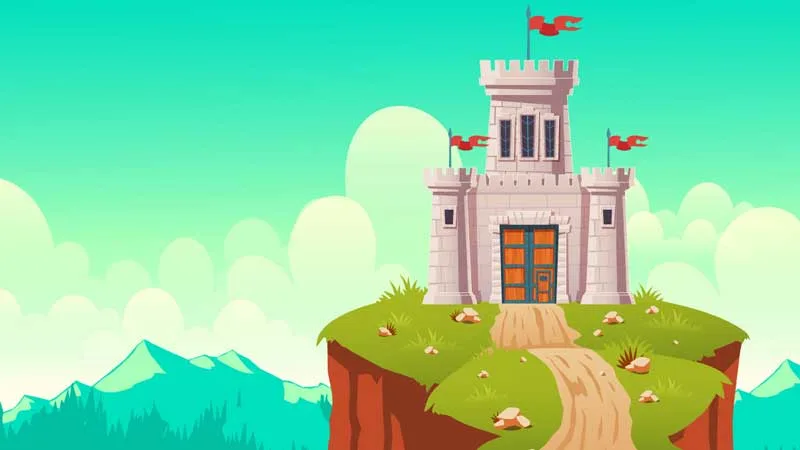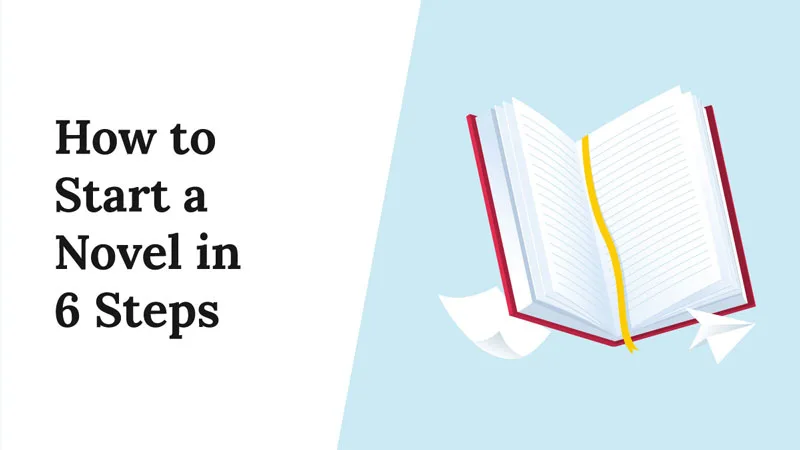Fantasy is about immersive worlds and unforgettable characters. It draws readers into places that feel as real as our own. A well-told fantasy casts a spell—one that makes readers believe in worlds that don’t exist… until they do.
Writing a fantasy novel can feel overwhelming, like holding a thousand puzzle pieces from ten different worlds. Where do you even begin? Do you start with a map? A prophecy? A sword-wielding girl with a birthmark marked by destiny?
If your idea feels massive and messy, you’re not alone. This guide breaks down how to write a fantasy novel into nine steps.
How to Write a Fantasy Novel
Fantasy is a beloved genre, and it’s thriving. According to a 2024 report by The Guardian, fantasy and sci-fi books bring in over $590 million a year in the U.S. alone, with fantasy sales rising more than 41.3% from 2023 into early 2024.
So if you’re looking to tap into a fast-growing, engaged market, the niche genre of fantasy has one of the most exciting opportunities for writers today.
Here’s how to write a fantasy story that makes people miss their subway stop, lose sleep, and clutch the book like it’s a portal to another realm.
Step 1: Understand the Type of Fantasy You’re Writing
Before you summon a single spell or map out your mystical land, ask yourself this vital question: What kind of fantasy am I writing? But this one decision will affect everything—your tone, world, characters, even how your magic system operates under pressure—what it can and can’t do when everything is on the line. It’s your north star. And to follow it, you’ll need to read. A lot.
Before you build your universe, visit others. Editor Chersti Nieveen, who has worked with bestselling authors like Brandon Sanderson (author of Mistborn and The Way of Kings), recommends choosing five to ten of your favorite fantasy books and studying them to understand what they do well. When you read fantasy as a writer, you’re not just enjoying the story—you’re learning how the genre works from the inside out.
Study how The Lord of the Rings layers lore like sediment in a mythical canyon. And look at how The Broken Earth Trilogy breaks genre boundaries—and rebuilds something new from the pieces.
Think of these novels as guides to the genre—your spellbooks, blueprints, and battle plans for crafting great fantasy fiction. And by studying how they work, you’ll also spot what sets them apart from other stories—whether it’s the worldbuilding, the rules of magic, or the way stakes are raised.
There are also plenty of others. Because fantasy fiction is a broad genre within speculative fiction, knowing where your story fits gives you direction. It also helps readers understand what to expect, so you can meet those expectations or subvert them like a mischievous wizard.
Generally speaking, each fantasy subgenre has its own rules, reader expectations, and storytelling tone.
Here is a brief rundown of major fantasy subgenres:
Fantasy Subgenres Overview
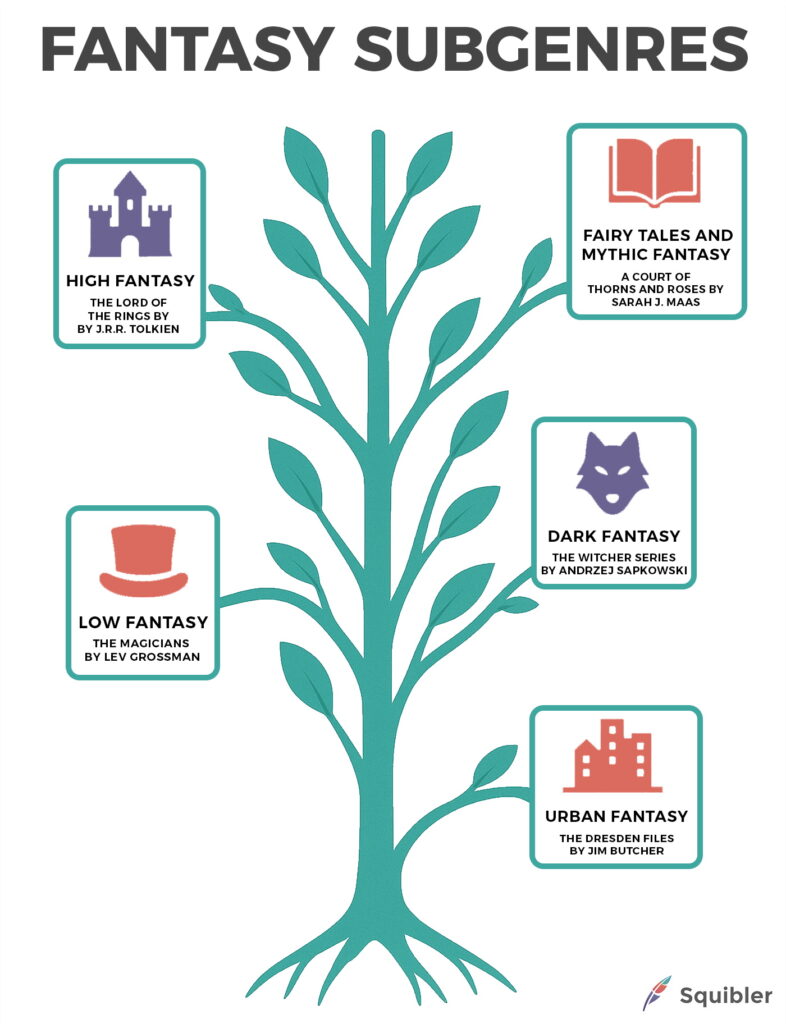
High Fantasy (Epic Fantasy)
This is set in a made-up world with its maps, languages, and ancient histories. Magic is everywhere and often central to the plot. Expect grand adventures, prophecies, heroic quests, power struggles, and a thread of romance among kingdoms.
As a writer, you’ll need to build your world from scratch—politics, cultures, even what counts as “normal.” J.R.R. Tolkien’s The Lord of the Rings exemplifies popular high fantasy books.
Low Fantasy
Takes place in real life (or something close to it), but with magical elements creeping in. You can expect more grounded storytelling. The magic is subtle or rare and causes more problems than it solves.
As a writer, focus on how magic disrupts the familiar. It’s less about spells and more about consequences. An example of a low fantasy book is The Magicians by Lev Grossman.
Urban Fantasy
Urban fantasy books are made up of magic living side by side with modern life. For instance, spells being cast in coffee shops and demons lurking under neon lights. You can expect a fast pace, gritty cityscapes, and magical beings hidden in plain sight.
As a writer, you’ll blend the rules of fantasy with the rhythms of the modern world. Popular examples of urban fantasy stories include The Dresden Files by Jim Butcher and Neverwhere by Neil Gaiman.
Fairy Tales and Mythic Fantasy
These are stories that draw from folklore, ancient myths, and fairy tales. They evoke a dreamy, symbolic tone. You can expect talking beasts, enchanted forests, curses, and moral lessons wrapped in lyrical prose.
As a writer, focus on theme and atmosphere. These stories feel timeless, even if you’re inventing them from scratch. Examples of fairy tales and mythic fantasy books include Katherine Arden’s The Bear and the Nightingale.
Dark Fantasy
This subgenre blends the supernatural and the sinister. You can expect morally gray characters, unsettling magic, and themes like death, madness, or corruption.
As a writer, lean into atmosphere and tension. Let your world challenge the line between wonder and fear. A well-known example of dark fantasy is The First Law trilogy by Joe Abercrombie.
Step 2: Build a World That Feels Real
Once you know where your story fits, it’s time to begin shaping the world that supports it.
If you want to enchant your readers, your world can’t feel like a half-formed sketch or a last-minute idea. Its fantastical elements need to feel lived-in, layered, and real. It has to breathe, ache, and feel like it’s been around long before your story started. Let people believe this place, your own world, could exist.
Good worldbuilding starts with questions like:
What does this world look like at dawn? At war? In winter?
How do people live? What do they eat, wear, worship, and fear?
Who holds the power? Who’s trying to pry it loose?
What grudges are still burning from centuries ago?
Do values shape love, law, and loyalty here?
What’s unspeakable, unbreakable, or unforgivable?
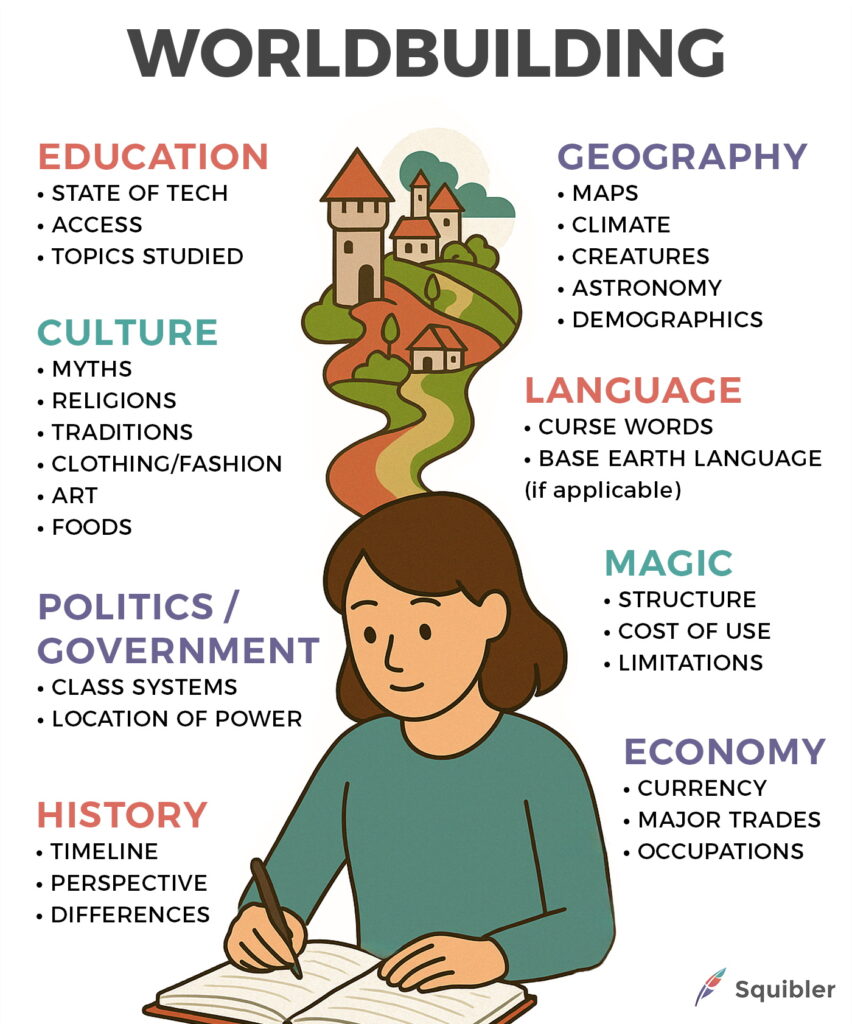
Let these questions guide you as you sketch landscapes, cultures, and conflicts. Think beyond just geography, dig into beliefs, superstitions, holidays, and slang.
And if you’re feeling stuck, borrow from history. For example, George R.R. Martin’s A Song of Ice and Fire mirrors England’s War of the Roses.
J.R.R. Tolkien’s The Lord of the Rings draws from Norse myth and Catholic morality, building cultures so distinct that even beings like the Ents—sentient trees with ancient grudges—reflect Middle-earth’s political and moral struggles.
Make your own rules, but respect them. The beauty of fantasy is freedom. You’re the architect of this world—the one who decides what’s possible and what’s forbidden. Want floating islands and sentient rivers? Go wild. But even architects need structure—rules that hold the world together. If magic exists, ask:
Who has it, and who wants it?
What does it cost—physically, morally, politically?
Is it a birthright, a bargain, a burden?
Who’s policing it… and what happens when someone breaks the code?
If your story says magic comes with a price, that price must be paid—no exceptions because you want a cool twist in chapter nine. The wonder hits harder when it’s grounded in rules people can learn, question, and anticipate. That’s when they stop reading and start believing.
Also, resist the urge to info dump. It’s tempting to reveal everything about your world at once, especially after all the time you’ve spent creating it. But don’t.
In J.K. Rowling’s Harry Potter, we didn’t get an encyclopedia entry. We got a cupboard, an owl, and a letter. That was enough to keep us reading.
Let people discover your world gradually—through everyday moments, surprising customs, and subtle clues woven into the story. Trust your readers to fill in the blanks. Trust the power of suggestion. People will get more thrill from stumbling upon a hidden rule than from reading it as a five-paragraph explanation.
Step 3: Create a Magic System with Limits
Magic should feel like fire: beautiful, dangerous, and never safe. When it’s done right, it doesn’t just dazzle—it drives the story. But for it to matter, it needs limits, logic, and consequences. Without those, even the most enchanted world falls flat.
Hard Magic vs. Soft Magic
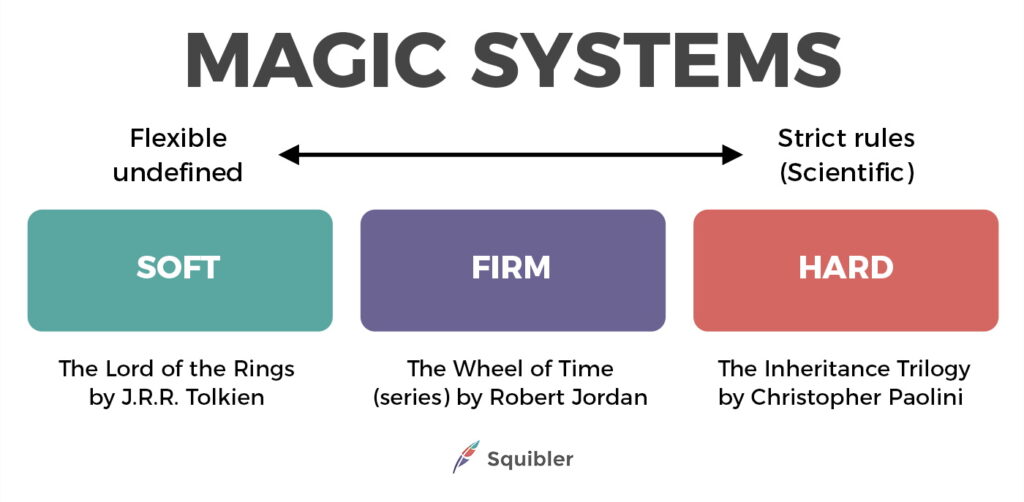
Here’s the difference:
Hard Magic
has clear rules. Readers know how it works, who can use it, and what it costs. For example, in
Mistborn
by Brandon Sanderson, characters swallow metals to use specific powers. Each metal does something different.
Soft Magic
is more mysterious. We don’t know how or why it works. For example, in
The Lord of the Rings
, Gandalf uses magic, but we’re never told how or what his limits are.
Most fantasy stories mix both. The important thing is to choose how much you want to explain, and then stick with it.For instance, in Mistborn, each metal grants a specific ability with clear rules. If you’re building a detailed system, check out Brandon Sanderson’s Laws of Magic.
Step 4: Craft Unforgettable Characters with Purpose
Ernest Hemingway once said, “When writing a novel, a writer should create living people; people, not characters. A character is a caricature.”
A breathtaking fantasy world (e.g., Middle-Earth or the world of The Poppy War) means nothing if readers don’t care about the people (e.g., Frodo Baggins, Rin) inside it.
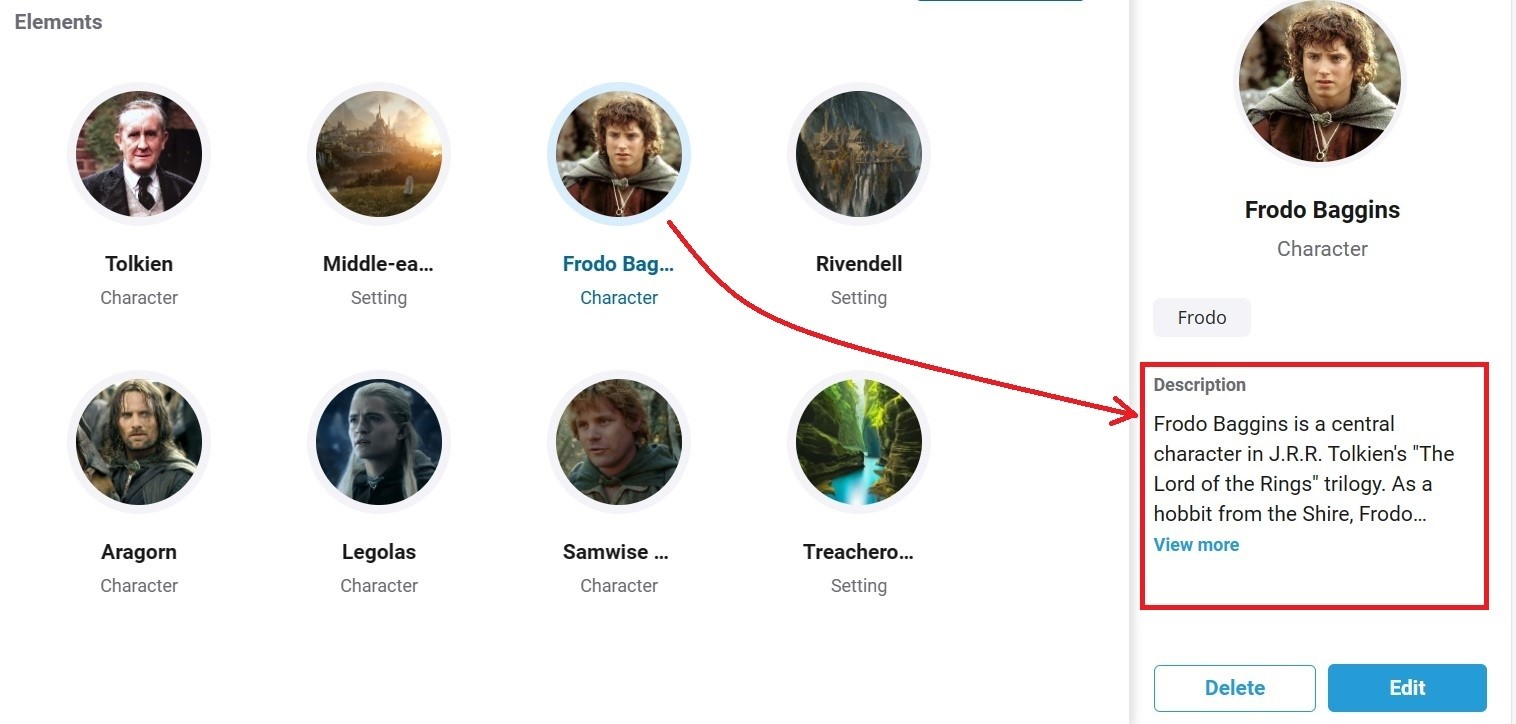
What makes a character unforgettable?
They have flaws—too stubborn, too afraid, too loyal for their own good.
They have desires—something they ache for, even if it breaks them.
There is internal conflict—a tug-of-war between who they are and who they’re becoming.
Think about how Rin in R. F. Kuang’s The Poppy War is ruthless, traumatized, and constantly battling herself. Or how Fitz in Robin Hobb’s The Farseer Trilogy is torn between duty, identity, and impossible choices. Fantasy also leans on archetypes—the Chosen One, the Reluctant Hero, the Tragic Mentor, the Dark Mirror. But who says your fantasy story has to follow these archetypes to the letter? Twist these roles. Maybe your villain isn’t downright evil. Maybe your mentor makes bad choices. Or your hero fails over and over before getting it right. This is how you create meaningful arcs.
When readers feel a character’s evolution, they don’t just watch the story but live it. And that’s how your world becomes unforgettable.
Step 5: Structure Your Plot with a Plan That Works
A breathtaking fantasy world means nothing without a plot that moves. You can have magical forests and talking dragons, but if your hero just vibes through it all, it will fall flat.
Imagine if Harry Potter were just about a boy who goes to school, attends a few classes, and waves a wand at lunch. No real danger, no dark secrets, no rising tension. Just homework and hallway chatter. Sounds dull, right? But it’s the plot; Harry learning he’s a wizard, facing danger, uncovering secrets, and growing with each challenge, that gives those places meaning.
That’s where story structure comes in.
Two tried-and-true frameworks rule the realm:
The Hero’s Journey (great for epic quests) – Starts with the ordinary world, then throws the hero into chaos: a call to adventure, trials, mentors, betrayals, and rebirth. Taran from The Chronicles of Prydain or Sabriel from Garth Nix’s Old Kingdom series are strong examples.
The Three-Act Structure (perfect for character-driven fantasy) – Act I sets the world and problem. Act II raises the stakes, twists the knife, and deepens the character arc. Act III delivers the payoff and the aftermath.
If you want to avoid the dreaded “soggy middle,” the slow, aimless stretch in the middle of a story where tension dips and momentum stalls. Add time pressure, toss in betrayal, and stir up emotional turmoil.
In all, make the plot and characters work together. Every major moment should push the most important aspects of your character arcs forward. If there’s a battle, it shouldn’t just be exciting but force the characters to make a choice. If there’s a betrayal, it shouldn’t just be shocking but also test the protagonist’s core beliefs.
Step 6: Write the First Draft Like Nobody’s Watching
This is the part where most writers get nervous: getting words on the page. Focus on getting your ideas down, even if the plot is rough or the dialogue needs work.
You can start with an outline if you’re a plotter, or go straight to writing if you’re a pantser. Choose the method that helps you enjoy writing the most—there’s no “correct” way to tell your story. This stage is about figuring things out. The point of a first draft is discovery. You’re exploring a new world, and sometimes, the only way to understand it is to write your way through it.
If you’re struggling with writer’s block, try prompts based on your fantasy story or do timed writing sprints. You can also skip ahead to a part you’re excited about or go back to what inspired you. Read a favorite fantasy scene and ask yourself: Why does this work? Use that spark to keep writing.
You could even write a short story set in your world to explore your system or a side character’s backstory—it’s a low-pressure way to deepen the world and unlock momentum.
Tools like Squibler’s fantasy writing template can help you stay organized.
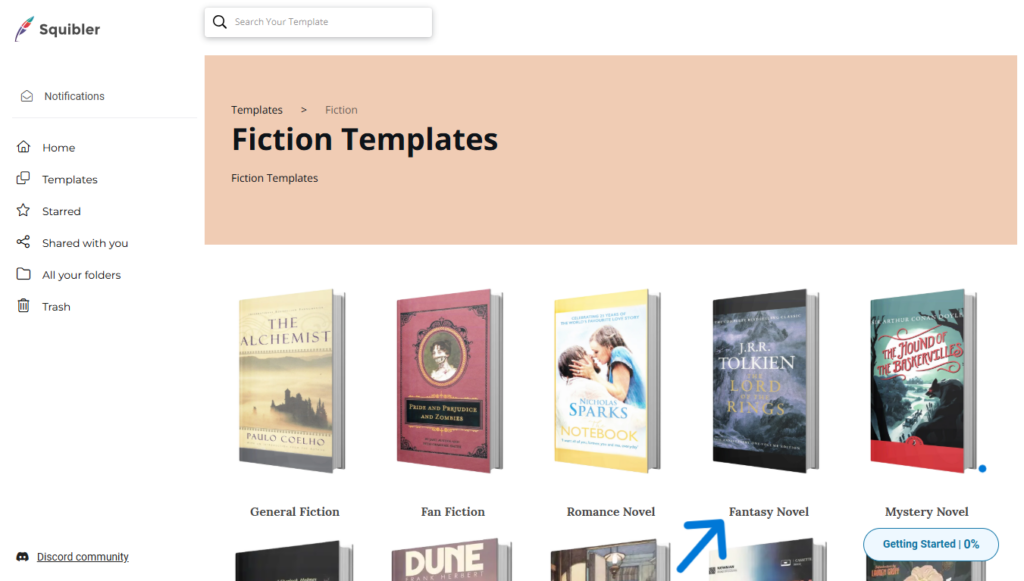
Avoid editing as you go; it slows momentum and encourages second-guessing. Revisions come later. For now, prioritize progress. The goal is simple: reach the end. You can’t improve what isn’t on the page.
Step 7: Layer in Themes That Stick
Theme is the subject matter of your story; the quiet force that gives your story emotional weight. It’s the idea, question, or tension that keeps showing up, even if you never say it out loud.
Many writers make the mistake of trying to force a theme onto their story from the start. Strong themes can come from lectures or planned speeches, but it’s even better if they emerge from the characters, choices, and world you’ve created. With time, recognizing these patterns becomes second nature—they show up without you forcing them.
Instead of deciding your theme up front, let it reveal itself. Ask questions like:
What patterns keep showing up in my characters’ arcs?
What kinds of choices or consequences keep repeating?
What does this world reward, and what does it punish?
For example, you may notice your story keeps circling around power and sacrifice. Your characters keep choosing between their strength and their relationships—not because you planned it, but because the story demands it. That’s a theme forming on its own.
In fantasy, you can break free from the constraints of realism—that’s one of its greatest strengths, allowing for epic stories. You can take emotional truths and make them literal:
Turn prejudice into magical law:
In Children of Blood and Bone by Tomi Adeyemi, the oppressive monarchy outlaws magic and brutally targets maji-born citizens based on ancestry.
Turn grief into a living shadow:
In A Monster Calls by Patrick Ness, a boy’s grief takes the form of a literal monster that appears nightly, forcing him to confront his deepest pain.
Turn fear of change into a cursed tradition:
In The Priory of the Orange Tree by Samantha Shannon, an ancient prophecy sustains rigid traditions and gender roles, and those who challenge it risk awakening a long-dormant evil.
Your world, your politics; everything can support your theme in ways other genres can’t.
In The Bone Season, Samantha Shannon ties magic to a person’s clairvoyant gifts, social status, and government control, making rebellion, identity, and secrecy essential to both survival and theme. You don’t need characters to monologue about the theme. Instead, let it show through:
Character decisions
– What happens when your protagonist betrays someone they love?
Consequences
– Does your villain succeed because the system allows it?
World logic
– Do class or bloodline determine who can access magic? Why?
Once you recognize your theme, refine it. Ask:
Does my worldbuilding reflect it?
Does my system challenge or reinforce it?
Do the major plot points push this theme forward?
Do my characters land on different sides of the theme?
Example: If your theme is legacy, have characters inherit certain spells—along with the burdens that come with them. If your theme is freedom versus control, show how those in power regulate magic, punish some for using it, and let others break the rules without consequence.
Step 8: Add the Final Touches—Covers, Titles, and More
Finishing your manuscript doesn’t mean the work is over—your final step is making it shine before it reaches your audience. A fantasy story lives or dies on its first impression, in particular, for new authors. Your cover, title, and publishing choices all work together to shape how people perceive your book before they even read a sentence.
Cover
Let’s start with the book covers. Whether you’re working with a designer or creating your own cover as a self-published author, your artwork should reflect your fantasy genre. That doesn’t mean clichés, but it does mean clarity. A sword-wielding figure in a misty forest gives off a different vibe than a neon-lit magical city. Fans of epic fantasy, urban fantasy, or fairy tales look for different visual cues. Your cover art needs to signal what kind of story they’re about to enter.
Title
The same goes for your title. It doesn’t have to explain the plot, but it should evoke the world or the mood. Think of titles like The Name of the Wind, Shadow and Bone, or Children of Blood and Bone. They feel like fantasy books, even if you don’t know what they’re about yet.
If you’re struggling with writer’s block, tools like Squibler’s fantasy title generator can spark ideas worth exploring.
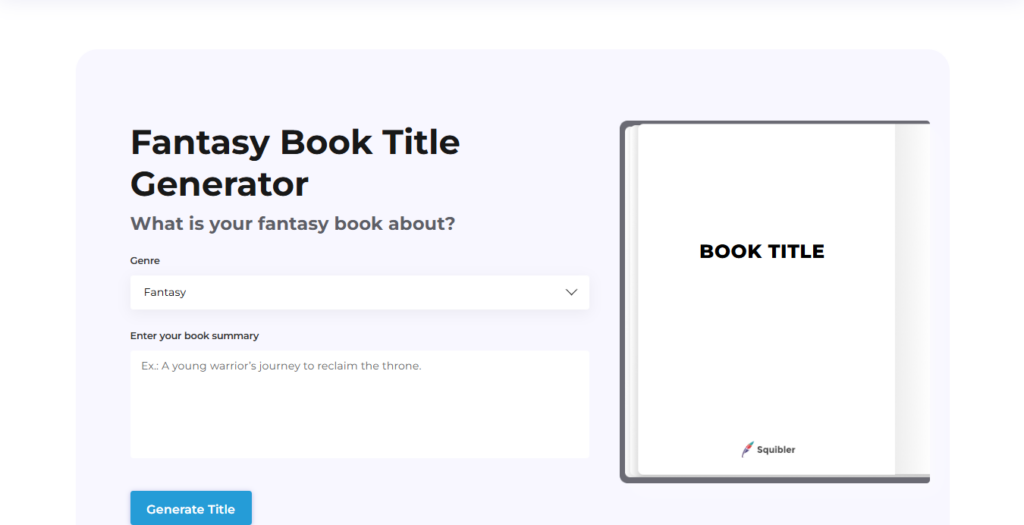
Publishing
This is also the moment to decide how you want your book to reach your audience. Self-publishing gives you full control over your release timeline, pricing, and design in a constantly changing publishing landscape. According to a Bowker’s report, self-publishing now accounts for over 30% of books sold in digital formats.
Getting traditionally published, on the other hand, offers editing, distribution, and marketing support. Buttraditional publishing is more competitive and slower. There’s no right path, only what fits your goals.
Step 9: Polish Your Fantasy Masterpiece
Your first draft lays the foundation—it’s where you shape the core of your story, even if it’s still rough. The real magic happens in revision(s).
Polish your story by going beyond grammar—tighten the pacing, raise the emotional stakes, and ensure your world and characters feel fully alive.
Start with one of the best tips: zoom out and look at your story structure. Do the major plot points hit at the right moments? Does your protagonist’s arc track well from beginning to end? Are the stakes escalating, or does the middle sag? Restructure scenes where the momentum dips or where character motivations feel thin.
Next, watch for the pitfalls that swallow fantasy writers whole. The big one is the dreaded info dump. Tighten the pacing. Raise the emotional stakes. Make sure your world and characters feel fully alive at every turn. Let your world unfold, like how careful hands shape fine gold.
Then it’s time to go smaller. Rework anything that feels flat or confusing, even if it’s just a single word—it all adds up. Tighten your prose until it sings. Eliminate repetition that doesn’t serve a purpose. Sharpen descriptions until they cut. Replace vague phrases like “it was amazing” with something concrete that leaves footprints in the reader’s imagination.
Writing software like ProWritingAid, Grammarly, or Hemingway can help you flag these issues.
But here’s the thing most beginning writers miss: you can’t see all your blind spots. A fresh perspective can help uncover those hidden issues in pacing, logic, or tone that you’re too close to notice.
You might start with a critique partner who tells it like it is. Later, bring in a beta reader who reflects your audience. If you’re aiming for professional polish, consider working with an experienced editor. You can even get feedback from a niche fantasy writers group on Facebook or Reddit.
Then, give your manuscript the read-aloud test. Hearing your words aloud brings out awkward phrasing or inconsistent rhythm that your eyes glaze over when reading. It’s amazing what your ears will catch that your eyes won’t.
Polishing isn’t glamorous, and it sure isn’t fast. But this is the difference between a book people forget and one they can’t stop talking about. And isn’t that what we’re all here for in the end?
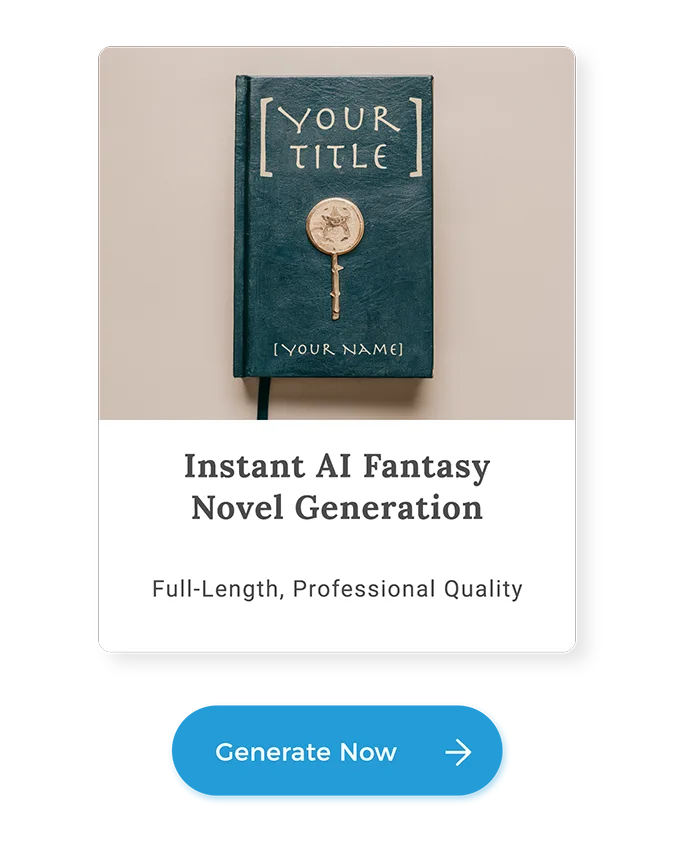
What the Pros Do Differently (And How to Learn From Them)
Legendary fantasy authors didn’t just wake up one day, sneeze out a saga, and land on the bestseller list. They made bold, deliberate choices that burrow into people’s hearts and never let go.
But you don’t need to write like them to learn from them. The world already has a Tolkien. Rowling made her mark. Sanderson built his school of magic. What it’s missing is you—your voice, your world, your magic. Still, it’s worth peeking behind the curtain to see how these icons pulled off their narrative wizardry.
J.R.R. Tolkien
Tolkien didn’t build a world; he unearthed a legend. Middle-earth feels ancient because, in his head, it was.
Tolkien created full languages—like Quenya and Sindarin, each with their grammar, history, and cultural weight.He didn’t treat them as decorative touches but built them as cultural pillars, all stemming from his background as a philologist. He blended influences from Finnish, Welsh, and Latin to give each language its own identity and history.
Ancient history haunted and shaped his characters. Aragorn’s bloodline, Isildur’s failure, the fall of Númenor; they all mattered.
Themes like fate, corruption, and sacrifice didn’t sit on top of the story—they pulsed through every scene.
J.K. Rowling
The magic of Harry Potter isn’t just the flying broomsticks. It’s the way every detail comes back with meaning. Rowling built a whimsical school and still wove an emotional arc across seven books that aged alongside her readers.
She foreshadowed. Horcruxes were seeded early in the story, and later revelations—like Snape’s loyalty and the Elder Wand—were carefully built on earlier groundwork. Her characters grew up. Harry from
Philosopher’s Stone couldn’t survive Deathly Hallows, but that’s the point.
Rowling didn’t just touch on themes like love and death; she made her characters wrestle with them.
Try this: Choose a core theme—like freedom, trust, or control. Then, walk through your plot. Are you testing that theme at every turn? Are your characters learning anything?
Brandon Sanderson
Like the others, Sanderson invented magic, but his systems are clean, logical, and ruthless. In Mistborn, you don’t just do magic. You earn it. You learn it. And sometimes, you lose it.
His magic has rules. Real, crunchy rules with costs and limits. No easy get-out-of-jail-free spells here.
Powers are interwoven with the plot. If you don’t understand the system, you can’t survive the story.
Magic revealed character. How someone uses their power says everything about who they are.
Try this: Write down three solid rules for how your magic works, and one painful way it could backfire. Then ask yourself: what happens when it does?
Legendary authors made their mark by fully committing to their craft, not by copying each other, but by following their vision. They followed their characters into the dark. They asked the hard questions. And they answered them, even when it hurt. You don’t need to mimic them. What matters is telling your story your way. So ask yourself:
Is my world believable on its terms?
Does my magic stir up problems, or solve them too easily?
Do my characters evolve in a way that mirrors my theme?
Those are the questions pro writers ask. And now, so can you.
Final Thoughts
Writing fantasy is about vision, not imitation. It’s your chance to build something bold, something only you could write. You also need structure, discipline, and revision. Whether you’re worldbuilding or rewriting your first chapter, your readers are waiting to escape into the world only you can build. On a lighter note, even your writing struggles are part of the story. Every plot hole and awkward sentence is a step toward mastery.
FAQs
Here are the most commonly asked questions about fantasy novels.
How do I start writing a fantasy novel?
Start with what excites you most: a character, a world idea, a piece of magic, or even just a question. Then begin to shape the story around it. Don’t worry about perfection—just get your ideas down. This anchors your story in action and voice. From there, you can explore the world and expand the plot. And if you’re stuck, read within the subgenre you love—it’ll spark ideas and show you what’s possible.
What is the structure of a fantasy novel?
Most fantasy books follow a familiar shape. You introduce the world and the protagonist, then trigger an inciting event. Tension builds through rising conflict. Eventually, there’s a major turning point—often a battle or revelation—followed by a resolution that reflects lasting change. Tools like the Hero’s Journey or the three-act structure can help map your plot and character arcs. But the best structure is the one that supports your story’s emotional journey.
What are the rules of writing fantasy?
There are no rules, but there are expectations. Your fantasy world needs to be internally consistent. Your magic system, if you have one, should follow its own logic. And your characters should make choices that feel grounded in their reality. Readers don’t need your world to be realistic; they just need it to make sense within itself.
Are fantasy books hard to write?
They can be, but they’re also incredibly rewarding. Writing fantasy involves juggling worldbuilding, plot, character development, and sometimes complex lore or history. The challenge is part of the fun. Breaking the process into clear steps, like in this guide, makes it far more manageable. Every fantasy writer starts as a beginner.

